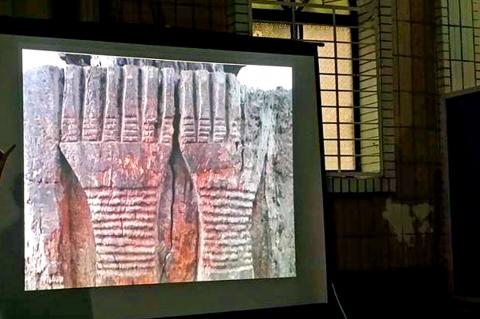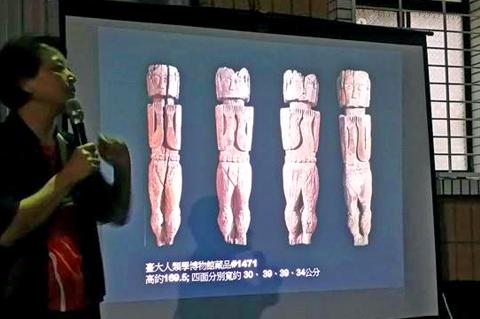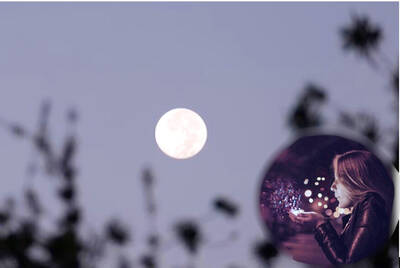The house of Zingrur, chief of Kaviyangan (Jiaping) Village in Pingtung County’s Taiwu Township, has ancestral house-posts carved with distinctive local totems. One of them, called a muakaikai, has images of female family ancestors carved on all four sides. As well as having six fingers on each hand, the carved figures have eyes on their knees. National Taiwan University has applied for this house-post to be listed as a national treasure and, following a review, the listing may be announced as early as the end of this month, making it the second ancestral post from Kaviyangan to be thus listed.
The muakaikai ancestral house-post is about 170cm tall. The human images are shown holding their hands up at chest level, and there are six fingers on the left and right hands. Multiple ring patterns on the wrists, arms and calves are a symbol of the local nobility. In addition, there are round, eye-like patterns on the knees. As to when the post was carved, it can no longer be known for sure.
The muakaikai ancestral house-post is a typical Kaviyangan-style carving, and the eyes on the knees and six-fingered hands stem from Paiwan myths and legends. This house-post was purchased in 1931 by the Japanese-era Taihoku Imperial University — today’s National Taiwan University (NTU) — for use as teaching material. According to research by the late Japanese architect Suketaro Chijiiwa, the muakaikai post is the only existing ancestral house-post in Taiwan that is carved on all four sides.

Photo: Chiu Chih-jou, Liberty Times
照片:自由時報記者邱芷柔
Adrucangalj Taluviljav, head of the social affairs section of Taiwu Township Office, says that a village meeting was held in Kaviyangan Village on March 2. Some people said they were worried that the wooden carving was becoming badly eroded and decayed. People at the meeting agreed that the ancestral pole could be listed as a national treasure and preserved forever. Members of the tribe think that if the muakaikai post is indeed listed as a national treasure, it should be treated as if it were a daughter of the village. They would like NTU to follow tradition by offering betrothal gifts such as earthenware jars and glazed beads, so that the muakaikai post can be “married off” in respectable fashion.
(Liberty Times, Translated by Julian Clegg)
屏東泰武鄉佳平部落大頭目金果祿(Zingrur)家屋的祖靈柱,雕有當地特殊圖騰,其中一根四面雕刻的祖靈柱,雕出家屋女祖先Muakaikai人像,該雕像不僅有六根手指頭,甚至在膝蓋上長有眼睛,該柱由台灣大學提出申請,最快將於月底通過審議,成為佳平部落第二支被列為國寶的祖靈柱。

Photo: Chiu Chih-jou, Liberty Times
照片:自由時報記者邱芷柔
Muakaikai祖靈柱高約一百七十公分,人像雙手平舉於胸前,左、右手各有六根手指頭,手腕、手臂和小腿處有多圈紋飾,是當地貴族象徵,膝關節處還雕有眼睛般的圈形紋,究竟何時雕刻已經不可考。
Muakaikai祖靈柱是典型的「佳平式」雕刻,膝蓋有眼睛、六根手指頭都源排灣族的神話故事,該柱在民國二十年被日治時代的台北帝國大學(現在的台灣大學)買下當教材,根據已故日本建築師千千岩助太郎的研究,Muakaikai是目前所知台灣僅存的四面雕刻祖靈柱。
泰武鄉公所社會課長莊德才說,佳平三月二日召開部落會議,族人因擔心木雕風化、腐蝕嚴重,而有共識希望祖靈柱能被列為國寶,永久保存下去,族人認為Muakaikai被指定為國寶後,就像部落嫁女兒一樣,希望台大能循古禮,以陶甕、琉璃珠等聘禮下聘,讓部落將Muakaikai祖靈柱風光出嫁。(自由時報記者邱芷柔)

★ Bilingual Story is a fictionalized account. 雙語故事部分內容純屬虛構。 Kevin leaned over the bubbling pot. “Hey. . . are you okay? You’ve barely touched your food.” Zoey blinked. Her face was red — not from blushing, but from the “mala” spice and the heat of the room. Her blond hair clumped to her face like strands of fine spaghetti. Her carefully applied makeup now streaked. “This isn’t what I expected,” she said softly, forcing a smile. All around them, Kevin’s friends were laughing, shouting, and tossing ingredients into the broth. The air smelled of chili oil and garlic.

Picture this: contestants are walking gracefully across a stage, competing for the highly desired title of “most beautiful.” However, these participants aren’t fashion models—they’re camels. Welcome to the extraordinary world of the Pushkar Fair, where beauty contests take on an entirely different meaning. The Pushkar Fair is held annually in the small desert town of Pushkar, India, usually in November. It began as a livestock trading event where farmers and herders gathered to buy and sell camels, horses and cattle. Over time, it has grown into a major cultural carnival that attracts thousands of tourists from around the world.

Continued from yesterday(延續自昨日) https://www.taipeitimes.com/News/lang If plushie charms are cute little nods to people’s interests, ita bags are full-on declarations. The term “ita” comes from the Japanese word itai, which means “painful” and reflects the overwhelming visual intensity of these bags. An ita bag is essentially a handbag, backpack, or tote meticulously decorated with an extensive collection of merchandise dedicated to a specific character or idol. These bags usually feature a clear plastic window to display carefully arranged pins, badges, keychains, or fan art. Both the interior and exterior may be covered in fandom memorabilia, creating an aesthetic so intense that it’s almost “painful”

對話 Dialogue 清清:華華,你知道嗎?聽說11月5號有「超級月亮」!那天的月亮會特別大、特別亮。 Qīngqing: Huáhua, nǐ zhīdào ma? Tīngshuō shíyī yuè wǔ hào yǒu “chāojí yuèliàng”! Nà tiān de yuèliàng huì tèbié dà, tèbié liàng. 華華:真的嗎?太棒了!我想去河邊看月亮,順便拍照片。 Huáhua: Zhēnde ma? Tài bàng le! Wǒ xiǎng qù hébiān kàn yuèliàng, shùnbiàn pāi zhàopiàn. 清清:聽說在超級月亮出現的那天晚上許願,願望比較容易實現。 Qīngqing: Tīngshuō zài chāojí yuèliàng chūxiàn de nàtiān wǎnshàng xǔyuàn, yuànwàng bǐjiào róngyì shíxiàn. 華華:是嗎?讓我好好想想要許什麼願。 Huáhua: Shì ma? Ràng wǒ hǎohǎo xiǎngxiǎng yào xǔ shénme yuàn. 清清:哈哈,我已經想好了,我希望「每天都準時下班」。 Qīngqing: Hāhā, wǒ yǐjīng xiǎng hǎo le, wǒ xīwàng “měitiān dōu zhǔnshí xiàbān”. 華華:嗯......我希望今年「年終獎金加倍」 Huáhua: ēn... wǒ xīwàng jīnnián “niánzhōng jiǎngjīn jiābèi”! 清清:等你把手邊的專案做完,你的願望一定可以實現的。 Qīngqing: Děng nǐ bǎ shǒubiān de zhuān’àn zuò wán, nǐ de yuànwàng yídìng kěyǐ shíxiàn de. 華華:希望一切能順利! Huáhua: Xīwàng yíqiè néng shùnlì! 翻譯